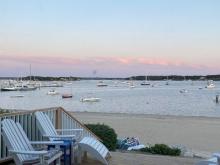Naturalist’s Corner: Coastal Exploration
Posted July 15, 2020
Written by Kyla Isakson
Summer is a great time to enjoy the warm weather, get outside, and relax at the beach. You don’t have to travel far to experience the wonders of the ocean and coastal habitats! In Massachusetts, there is a wide variety of organisms that can be found on the beaches in our area. There are plenty of seaweeds in the ocean and along the beaches in Massachusetts, including the Sea Belt (Saccharina latissima). Sea Belt, also known as Sugar Kelp, is a large brown algae that occurs in long strips. Sea Belt grows quickly, and it typically lives for two to four years. Seaweeds and other photosynthetic organisms are responsible for producing oxygen that humans and other organisms need to survive.
In addition to seaweeds, the Northwest Atlantic Ocean is home to many types of mollusks, including the Common Atlantic Slippersnail (Crepidula fornicata). These sea snails have an oval shaped shell that is a dull white with wavy, light brown stripes. Common Atlantic Slippersnails are filter feeders, and they mostly eat phytoplankton and algae that float in the water column. They have a foot for mobility and are typically anchored to a hard substrate when they reach maturity. Slippersnails are sequential hermaphrodites, which means that they are born as males and transition to females as they age. You might find a stack of Common Atlantic Slippersnails, which makes for easy reproduction, as the young males are found on top and the older females are on the bottom of the stack.
The beaches in Massachusetts are also a great place to observe shorebirds like plovers, sandpipers, and oystercatchers. There are several species within these bird groups, and their characteristics can vary between sex, age, and season, so keep an eye out for them the next time you’re at the beach! To learn more about how to identify these shorebirds, watch the tutorial created by TerraCorps Service Member Mike Perrin on how to use the Merlin Bird ID app.
















